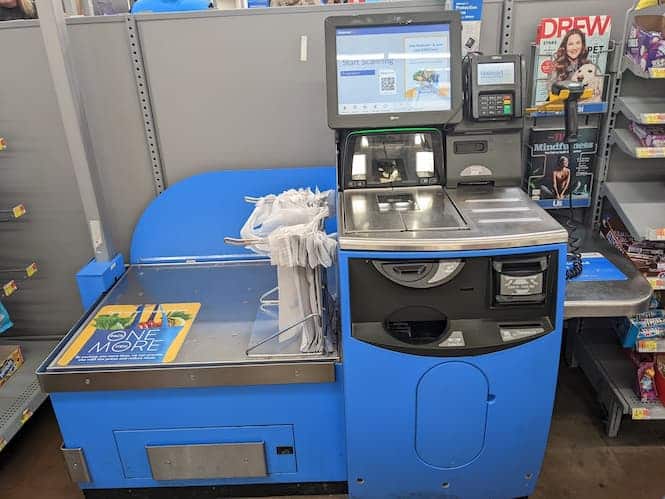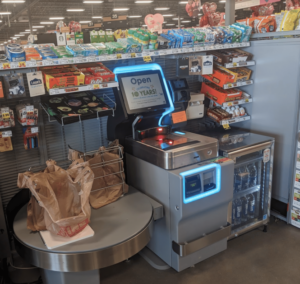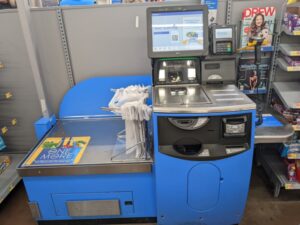
Self-Checkout or Not to Self-Checkout?
CNN ran an article on “Nobody likes self-checkout”. It made some good points albeit short on any backfill data to support. It hinged on study by an academic and built a negative narrative around that. Covering it ss the only way to make our own balanced viewpoint more balanced. The premise “nobody likes” is a tell of sorts. Most people prefer self-service when you run the numbers. CNN editors are driven by serving up semi-incendiary newsbites to specific audience segments and in the self-service industry we have had to deal with the usual anti-automation, “replaces workers”, and a long list of other complaints, for a very long time. Andrew Puzder with Carl Jrs. and CKE was particularly active. Automation is scary sometimes to many people. As one of our members said, “most things come about as cost cutting when you get down to it”.
Perhaps we could add is that young writers for publications should consider, that without providing a somewhat balanced review, they are mot likely doomed to be replaced by AI content generators…
There are advantages and disadvantages to anything but convenience tends to be a winner. People stopped going to banks for cash (mostly) when ATMs came out for example. It was more convenient. Some people despise mobile phones, but our guess mobile usage is only going to increase, generally because it more convenient as well more times than not.
Our prediction is more types of self-checkout will be used. Product labeling and packaging will continue to improve. Problem areas like produce will be solved with new scanning systems and AI engines. [Meanwhile my Luddite wife avoids the cashier lanes, unless her favorite cashier is working and she has chance to socialize with her. ]
For more information email [email protected] — Any of our Gold sponsors can help when it comes to self-checkout technology.
Olea Kiosks, Inc. kiosks, KioWare software, Pyramid Computer kiosks, Nanonation Software, KIOSK Information Systems kiosks, Kiosk Group tablet kiosks, Vispero Kiosk Accessibility, 22Miles digital signage software, Intel Kiosk embedded computing, American Kiosks kiosks, Esper Android Cloud Solutions, Panasonic Restaurant Solutions, LG Electronics Business Solutions displays, FEC Kiosks – Self Checkout, IDmission – Instant ID via Mobile & Kiosk, WelcomeWare – live receptionist, Pitney Bowes – Service & Logistics, Star Micronics – receipt, POS, kiosk printers
In Brief
- Audio can be irritating — maybe but for the disabled customer the lack of audio can result in very poor outcomes with the “helpful” staff. Imagine you are disabled and getting assistance with the cash back function. That requires trust.
- Survey says “67% experienced a failure” at SCO lanes — That is from Raydiant (see below). A relatively new company out of digital signage and just got some funding. Their website is a pitch deck for funding. Here is their kiosk page.
- Disadvantages for stores listed are expensive to install, often break down and lead to customers purchasing fewer items. They incure higher losses and more shoplifting at self-checkout. — not sure where all that data comes from but other sources such as Oliver POS, Capgemini, NCR say otherwise.
- According to Civic Science’s recent U.S. survey, 46% of respondents aged 18-34 prefer using self-service over service with a cashier. Likewise, the NCR states that the main reason customers like self-checkout is the convenience.
- Self-Checkout is still growing. 29% of transactions at food retailers were processed through self-checkout, up from 23% the year prior, according to the latest data from food industry association FMI. — this is a data stat from FMI on supermarkets for sure.
- Why is an unloved technology still proliferating? — Not sure that premise is true. Having multiple ways to checkout for multiple circumstances, while raising number of transactions and lowering cost, seems clear to us. It isn’t generally a one solution fits all given the supermarket shoppers. Aldi and others have developed a focus on those customers wanting quick and fast. They don’t deal with the slow and problematic. A bit unfair but surely optimized.
- The writer calls out CheckRobot as first installed at several Kroger Stores — the real pioneer in the space was Optimal Robotics. In 2001 they hit the 5000 units mark at Kroger. No wonder that Fujitsu bought them in 2004.
- 2004 — IHL’s market study also reported that shipments of self-checkout systems will grow by about 95 percent in 2004, with the market exceeding $1.3 billion in 2005. Greg Buzek, president of IHL, estimates that 95 percent of the supermarket chains in North America will have some degree of self-checkout by 2006. “Self-checkout is an absolute necessity, as supermarkets face pressure from Wal-Mart,” Buzek said. “It allows them to shift employees to higher-profit areas of the store, and it gives them a competitive advantage.”
-
Although self-checkout counters eliminated some of the tasks of traditional cashiers, they still needed to be staffed and created a need for higher wage IT jobs, he said. Self-checkout, Andrews added, “delivers none of what it promises.” — — The intent was not to reduce employees. Hybrid checkouts are complex and of course come with support and maintenance. NCR has an entire building in Bentonville just for self-checkout support staff. Even “just walk out” stores have people, just not in the usual roles and places.
- Despite all of these “shortcomings”, self-checkout is only expanding.
- FOMO (fear of missing out) and the “arms race” drives stores — there is some basis in that but self-checkout was slated to be installed of 95% of stores in 2004 according to IHL Group, who is a smart research firm. We are checking Buzek for comments.
Picture of Typical Unit
Excerpt
New York (CNN Business)”Unexpected item in the bagging area.”
“Please place item in the bag.”
“Please wait for assistance.”
If you’ve encountered these irritating alerts at the self-checkout machine, you’re not alone. According to a survey last year of 1,000 shoppers, 67% said they’d experienced a failure at the self-checkout lane. Errors at the kiosks are so common that they have even spawned dozens of memes and TikTok videos.
“We’re in 2022. One would expect the self-checkout experience to be flawless. We’re not there at all,” said Sylvain Charlebois, director of the Agri-Food Analytics Lab at Dalhousie University in Nova Scotia who has researched self-checkout.
Customers aren’t the only ones frustrated with the self-checkout experience. Stores have challenges with it, too.
Comments
It is a typical article about technology in mainstream press. It has one view and every piece of data supports that view. In this case the view is self-checkout is negative, it is put in only because companies are greedy and it ignores the balanced realities of the technology. And this fits the narrative that a negative story gets 10x the clicks of a positive or balanced story. I was interviewed for more than 20 minutes by this author and not a single bit of my discussion made the article. Among other things, retail is short 4 million workers but customers still want the best prices and the fastest way to checkout. Self-Checkout allows retailers to put their workers where they are most valuable. They save cost on the per transaction basis, but it frees labor for being in the aisles to help, trying to make sure shelves are stocked, and making sure prepared meals that consumers want are prepared.
Next, regarding the security features. Those are there and so heightened because unfortunately there is a segment of the population bent on stealing from stores or feel entitled to steal from the stores. So there are scales for weights, cameras for protection. Home Depot decided to remove their security options to streamline the process. And it has been wonderful for the honest consumers…no system to bark at you. Very quick, very efficient. The problem was, however, that their losses from theft doubled…increased by over $1b in losses so they have to enhance security in other areas.
The reality is that there are good things and bad things about self-checkout. One can argue either side. The truth of the matter is that the old way of staffed checkouts is not coming back and the use of self-checkout is going to continue to grow. There simply are not enough people willing to work the stores. It was clear that the academic originally quoted had a negative view of self-checkout…so the entire article was about building that narrative with no concern for balance or realities among consumer desires and retailer’s realities.
Greg Buzek with IHL Group. Recommended — Free OnDemand Webinar — Securing the Future of Grocery
It was interesting how they spoke about these things coming about because the cost cutting measures vs. it being something cool for the customer. I think most things come about as cost cutting when you get down to it. Or if it is customer experience then its done for other reasons. Sort of like Santa Claus in the mall or ice skating etc… Done as a draw to get people in the door to spend money. Clearly a self-checkout kiosk does not fall into that category.
I am intrigued though on how to make it a better experience. I’ve found that I’m getting much better at the Fujitsu units at my local grocery store. I’m pretty proficient with them and choose to use it whenever I have only a few items. It gets me on my way much quicker. But how to make it fun or pleasurable and not like pumping gas. That is a thought.
Other links
- Walmart supermarket conveyor belts replacing cashiers
- Kroger rolling out conveyor belts for self-checkout
- July 2022 – Walmart Corporate on new Checkout
Problem Areas
Produce —
Self-checkout can be a pain point for shoppers buying produce. More than three in 10 shoppers steer clear of fresh produce when using self-checkout, the Food Industry Association noted in a recent report.
Instead of having to remember the four-digit item code or search through the menu of products to find it, companies like Extenda Retail, KanduAI and Toshiba are looking to make the process simpler and faster with produce recognition solutions. Arigi of Kroger said during NRF that produce recognition software is of keen interest to the grocery chain as it looks to further innovate in self-checkout.
KanduAI, a technology company started in 2018 and headquartered in Tel Aviv, Israel, uses deep learning and artificial intelligence to recognize fruits and vegetables and provide a short list of possibilities to consumers. Shoppers can select if the item is organic or not.
From Grocery Dive
Survey Says (from Raydiant in 2021)
Key Findings
Self-service checkout usage has dramatically increased. 36% saw a major increase in usage while 23% saw a minor increase.
Most expect their usage to increase in the upcoming 12 months. 34% expect a major increase while 18% expect a minor increase
Self-Service checkouts have failed for many consumers. 67% have had one fail when using it.
Bad experiences are why consumers choose not to use self-service checkouts. 25% said they would choose not to because they’ve had bad experiences while 21% said in the past they were slower.
Most believe self-service checkouts are faster than waiting in line. 85% believe strongly that they are typically faster.
Consumers would prefer to use their smartphone to checkout and pay. 65% strongly agree that their usage would increase if this option was available.
Consumers worry about the cleanliness of self-service options. 65% strongly agree with this concern.
Consumers prefer self-checkouts over store associates if given an option. 60% of consumers prefer them.
Part 1: Self-Service Checkout Usage
Any location manager evaluating the self-service checkout kiosks must ask: do customers actually use these kiosks? To what degree do they prefer self-checkout over having a cashier scan and bag their items?
Our data suggests that customers utilize self-checkout frequently, and that usage of self-service kiosks may continue to increase.
Consumers are using self-service checkouts a lot, and usage has dramatically increased.
Our findings suggest that almost half of the shopping population use self-checkout exclusively. When asked how often they use a self-service checkout kiosk when it is available, 48.7% of respondents said “basically all the time”.
30.6% of respondents said that they use self-service checkout kiosks “some of the time”. These respondents could adjust their checkout habits based on the length of cashier lines, the nature of the items they are purchasing, or other personal preferences. These shoppers embody the need to have both self-checkout kiosks and live cashiers in a store.
Only 3% of respondents said they “don’t use [self-checkout] and don’t want to”. These findings show that having self-checkout options is not a competitive advantage, but a competitive requirement.


